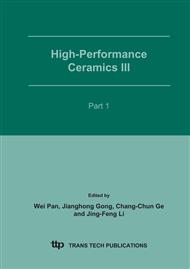[1]
D. Peterson and J. Winnick: J. Electrochem. Soc. Vol. 143 (1996), pp. L55.
Google Scholar
[2]
B. Zhu: FC Bull. Vol. 4 (1999), p.9.
Google Scholar
[3]
N. U. Pujare, K. J. Tsai, and A. F. Sammell: J. Electrochem. Soc. Vol. 136 (1989), p.3662.
Google Scholar
[4]
I. V. Yentekakis and C. G. Vayenas: J. Electrochem. Soc. Vol. 136 (1989), p.996.
Google Scholar
[5]
T. Inoue, T. Setoguchi, K. Eguchi and H. Arai: Solid State Ionics Vol. 35 (1988), p.285.
Google Scholar
[6]
T. J. Kirk and J. Winnick: J. Electrochem. Soc. Vol. 140 (1993), p.3439.
Google Scholar
[7]
B. Zhu and S. W. Tao: Solid State Ionics Vol. 127 (2000), p.83.
Google Scholar
[8]
B. Zhu and B. -E. Mellander: Solid State Ionics Vol. 97 (1997), p.535.
Google Scholar
[9]
B. Zhu and B. -E. Mellande: J. Power Sources Vol. 52 (1994), p.289.
Google Scholar
[10]
B. Zhu and B. -E. Mellander: Solid Oxide FCs-VI (The Electrochemical Society, Inc., Pennington, NJ, 1999S. ), S. C. Singhal and M. Dokiya (Eds. ), p.244.
Google Scholar
[11]
B. Zhu: J. Power Sources Vol. 114 (2003), p.1.
Google Scholar
[12]
B. Zhu: Electrochem. Commune. Vol. 1 (1999), p.242.
Google Scholar
[13]
A. Lunden: Materials for Solid State Batteries (World Scientific Publ. Co. Singapore, 1986), B.V. R. Chowdari & S. Radhakrishma (eds), p.149.
Google Scholar
[14]
A. Lunden and J. O. Thomas: High Conductivity Solid State Ionic Conductors (World Scientific Publ. Co. Singapore, 1989), T. Takahashi (ed. ), p.45.
Google Scholar
[15]
J.C. Sun, M.T. Sun, S.J. Ji, X.R. Liu, Z.G. Zhu, B. Zhu: Preparation and characterizations of Li2SO4-ceria composite electrolytes, submitted to Solid State Science.
Google Scholar
[16]
C. C. Liang:, J. Electrochem. Soc. Vol. 120 (1973), p.1289.
Google Scholar
[17]
P. Hatwig, W. Weppner: Solid State Ionics Vol 3-4 (1982), p.249.
Google Scholar
[18]
K. Shahi, J. B. Goodenough: J. Solid State Chem. Vol. 42 (1982), p.107.
Google Scholar
[19]
J. Maier: J. Phys. Chem. Solids Vol. 46 (1985), p.309.
Google Scholar
[20]
C. W. Nan: Progress in Mater. Sci. Vol 37 (1993), p.1.
Google Scholar
[21]
B. Nettelblad, B. Zhu and B. -E. Mellander: Phys. Rev. Vol. B 55 (1997), p.6232.
Google Scholar
[22]
A. Mineshige, T. Yasui, N. Ohmura, M. Kobune, S. Fujii, M. Inaba and Z. Ogumi: Solid State Ionics Vol. 152-153 (2002), p.493.
Google Scholar
[23]
M. Godickemeier, K. Sasaki, L. I. Grauckler and I. Riess: J. Electrochem. Soc. Vol. 144 (1997), p.1635.
Google Scholar
[24]
S. P. S Badwal and F. T. Ciacchi: Solid State Ionics Vol. 121 (1999), p.262.
Google Scholar
[25]
B. Heed, B. Zhu, B. -E. Mellander and A. Lundén: Solid State Ionics Vol. 46 (1991), p.121.
Google Scholar


